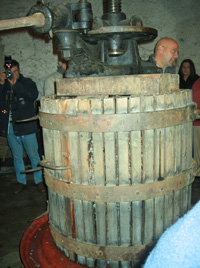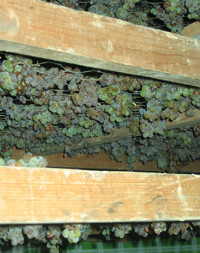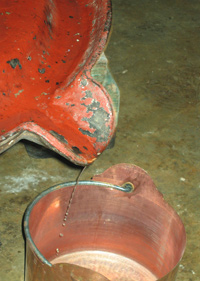Sweet wines have a long tradition in Italy, but until recently they attracted little attention. Gradually, however, interest in "dolcezza" is also growing in the boot country and noble sweet wines, such as the Vino Santo from Trentino, are gradually attracting the necessary attention.
 |
| Handcrafted according to old tradition |
When one speaks of vino or vin santo, most people think of the sweet wines of Tuscany, often not very multifaceted, into which one dips crispy biscotti at the end of a meal. Even in most wine guides, under "Vin(o) Santo" you will find almost only information about the "sacred wines" of Tuscany. The finesse-rich sweet wines from Trentino, more precisely from the Valle dei Laghi, a narrow valley that stretches west of the Brenner motorway between Trento and Rovereto, are - quite unjustly - forgotten.
Unlike the Vin Santo from Tuscany, the Vino Santo not only has one letter more, the grapes, dried by the gentle wind of Lake Garda, are only pressed in Holy Week according to centuries-old tradition and inspire with their finesse and freshness. Only a handful of winegrowers produce Vino Santo Trentino DOC exclusively from the Nosiola grape, a genuine Trentino native.
 |
| To dry for half a year in wooden crates with grating |
The Nosiolo grapes are placed in wooden crates with grates to dry and then remain in the airy attics of the wineries for about half a year. The constant fresh breeze (l'òra) that blows from Lake Garda northwards through the "Valley of the Lakes" every day in the afternoon dries the grapes and ensures the noble rot that gives the Vino Santo its finesse.
Every year during Holy Week, Vino Santo winemakers, journalists and wine lovers gather - this year in the beautiful Castel Toblino in the Valle dei Laghi (Trentino) - to witness the official pressing of the 2006 Vino Santo, accompanied by local songs of the Trentino men's choir "Coro Valle dei Laghi". After the laborious manual pressing, the sweet must is fermented for two to three years. Afterwards, the noble juice matures in small oak barrels for at least 8 to 10 years. After bottling, the noble drops last for many years - if they are not drunk with relish beforehand.
 |
| 15 to 18 litres of must from 100 kg of grapes |
After drying for six months, 15 to 18 litres of Vino Santo must are obtained from 100 kg of fresh grapes. The sweet meditation wines captivate with an intensive play of aromas of ripe and dried fruits, especially quinces, apricots and orange zest combined with aromas of nuts, honey and spices. The fine acidity gives the wines elegance. Vino Santo goes perfectly with typical Trentino dolce, such as Torta di Fregoloti or apple strudel, but is also a fantastic companion to Gorgonzola piccante, Stilton or Blue D'Auvergne and foie gras and tastes naturalmente also solo, to relax after a busy day.
PS:
From the freshly harvested Nosiola grapes, a fresh, finely aromatic white wine is pressed in the northern part of Trentino, which is drunk young. It is "the" house wine of the Trentino people, which is now also becoming more and more popular with us. In Trentino, this palatable white wine is served with antipasti, trout, pasta or risotto with vegetables.
The autochthonous grape variety thrives best on the slopes and hills, especially in the Valle dei Laghi or Sarca Valley and in the Adige Valley and on the hills of Lavis.
For some years now, some producers have been paying special attention to this grape variety: they reduce the yield, let part of the harvest mature in barrique barrels and then blend it again with the wine vinified in steel. The Cantina Toblino and the Az. Ag. Pravis presented their new wine "L'Ora" on the occasion of the Vino Santo pressing 2006: A Nosiola, vintage 2004, aged for one year in acacine barrels. An exciting wine for which there was much applause.